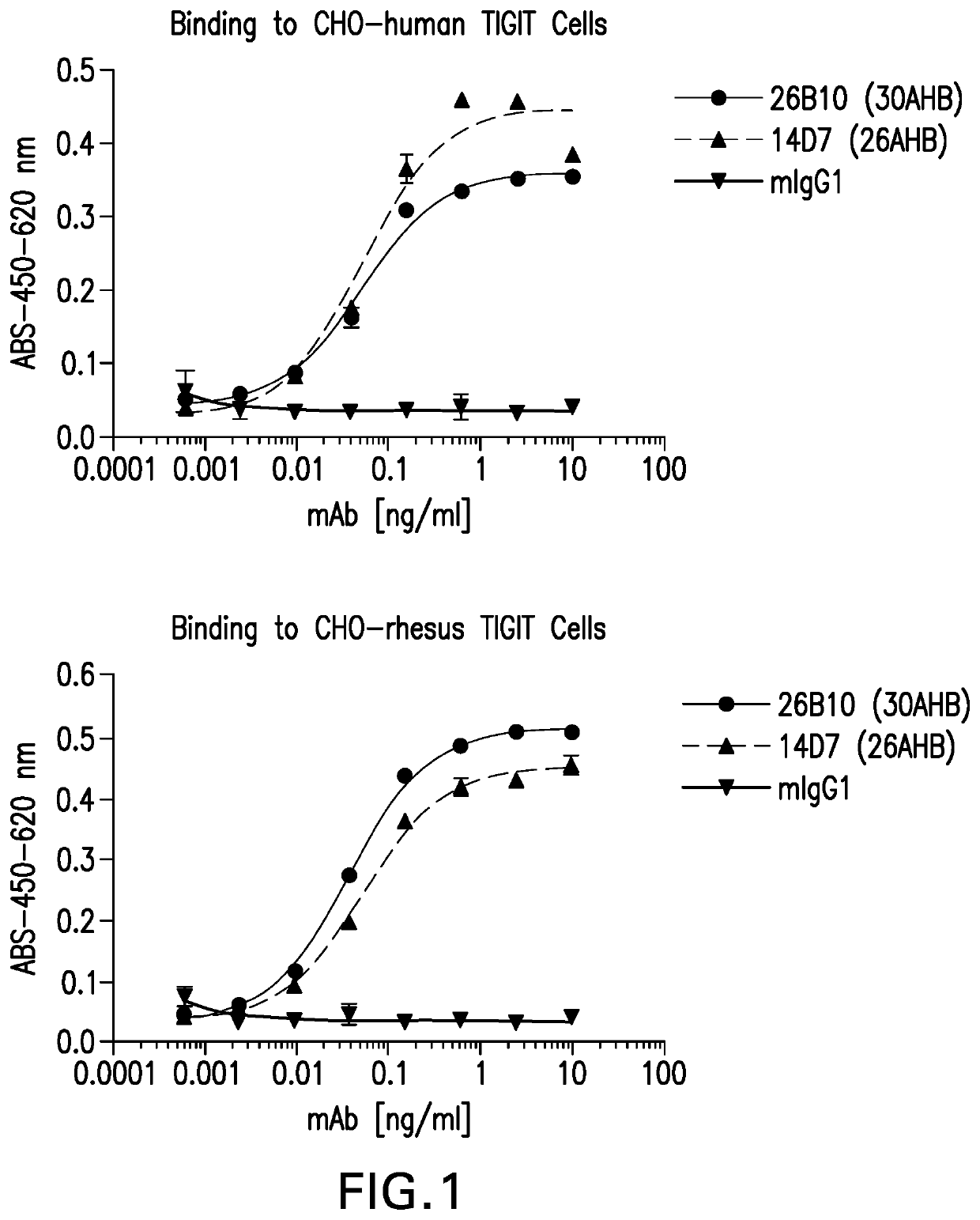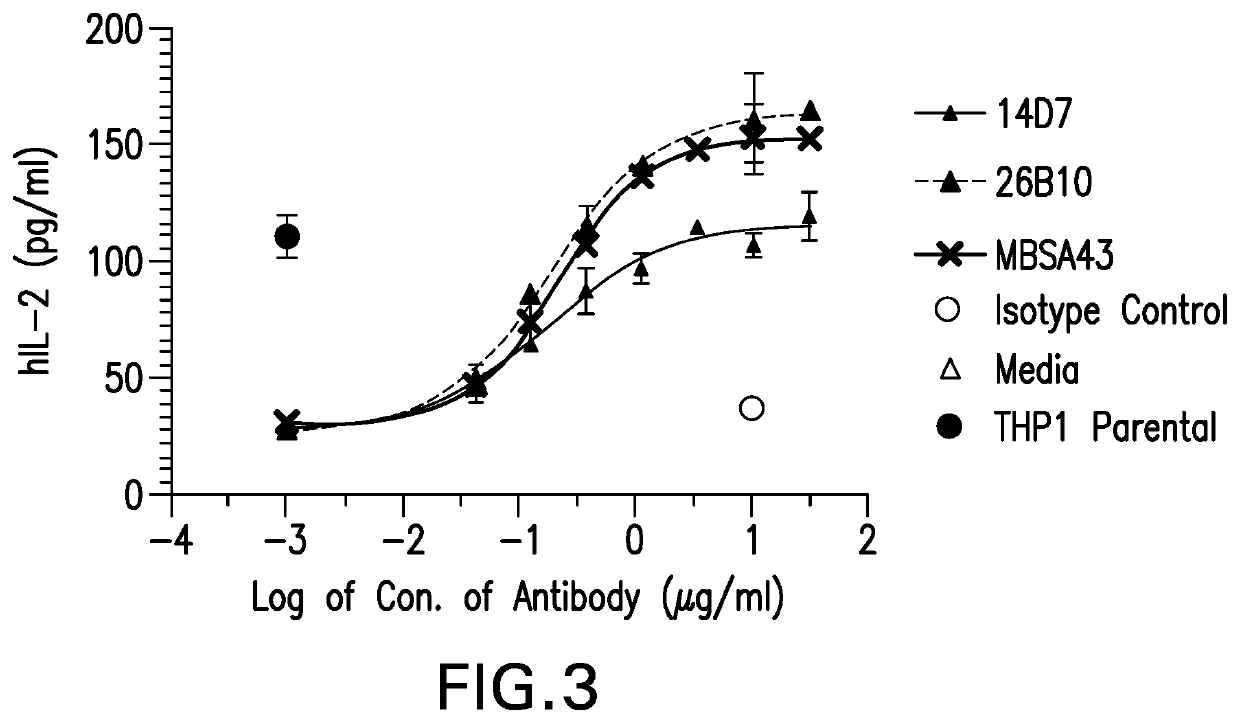Anti-TIGIT antibodies
a technology of anti-tigit antibodies and t-cells, which is applied in the field of anti-tigit antibodies, can solve the problems of poor prognosis, and overexpression of pd-l1 in tumors, and achieve the effects of stimulating antigen-specific t-cell production, and reducing tumor specific t cell exhaustion
- Summary
- Abstract
- Description
- Claims
- Application Information
AI Technical Summary
Benefits of technology
Problems solved by technology
Method used
Image
Examples
example 1
Generation of Mouse Anti-hTIGIT Antibodies
[0305]To generate antibodies to human TIGIT, Balb / C mice were immunized with human Fc-tagged human TIGIT recombinant protein using RIBI adjuvant and footpad injection on a biweekly schedule. Immunized animals were bled and serum titers determined for binding to human TIGIT transfected CHOK1 cells using a cell-based ELISA (described below). The animals with the highest titers were given a final boost with recombinant protein and draining popliteal lymph nodes isolated four days later. Hybridomas were generated by electrofusion of isolated lymphocytes with the myeloma fusion partner P3X63-AG8.653 using the Cytopulse Hybrimmune electrofusion system. Fused cells were plated in 96-well plates in DMEM / FI 2, 15% BCS, HAT, IL-6, OPI supplement, and gentamycin.
[0306]Hybridoma supernatants were assayed for binding to human TIGIT expressing CHOK1 cells and cross-reactivity to cynomolgous and rhesus TIGIT expressing CHO cells using a cell-based ELISA fo...
example 2
Characterization of Anti-hTIGIT Antibodies
[0308]Supernatants from positive clones were tested for their ability to block recombinant human CD155-huFc protein binding to hTIGIT CHOK1 cells in a cell-based ELISA format. Human TIGIT-CHO-K1 cells were plated in 96-well plates as described above. Media was removed from the plates and 50 μl of hybridoma supernatant was incubated with the human TIGIT CHO-K1 cells at 4° C. for 30 minutes. Fifty microliters of human CD155-huFc was added to the plate for a final concentration of 0.5 μg / ml of human CD155-huFc and incubated for 30 minutes at 4° C. Assay plates were washed 3 times with PBS / 0.05% Tween-20 as above. Binding of human CD155-huFc to the hTIGIT-CHOK1 cells was detected using an HRP-conjugate F(ab)′2 goat anti-human IgG secondary antibody (Jackson 109-036-098) at 1:2000 dilution in CHO-K1 media. Plates were developed using TMB and stopped using TMB Stop Solution as described above and the A450-620 nm determined.
[0309]A mouse antibody g...
example 3
Humanization of Antibodies
[0318]The 14D7 and 26B10 mouse antibodies were humanized using methods described in the specification. From antibody 14D7, the following humanized variable heavy chains were constructed: SEQ ID NOs: 9-12; and the following humanized variable light chains were constructed: SEQ ID NOs: 13-16. From mouse antibody 26B10, the following humanized variable heavy chains were constructed: SEQ ID NOs: 25-28; and the following humanized variable light chains were constructed: SEQ ID Nos: 29-32.
PUM
| Property | Measurement | Unit |
|---|---|---|
| temperature | aaaaa | aaaaa |
| temperature | aaaaa | aaaaa |
| temperature | aaaaa | aaaaa |
Abstract
Description
Claims
Application Information
 Login to View More
Login to View More - R&D
- Intellectual Property
- Life Sciences
- Materials
- Tech Scout
- Unparalleled Data Quality
- Higher Quality Content
- 60% Fewer Hallucinations
Browse by: Latest US Patents, China's latest patents, Technical Efficacy Thesaurus, Application Domain, Technology Topic, Popular Technical Reports.
© 2025 PatSnap. All rights reserved.Legal|Privacy policy|Modern Slavery Act Transparency Statement|Sitemap|About US| Contact US: help@patsnap.com



